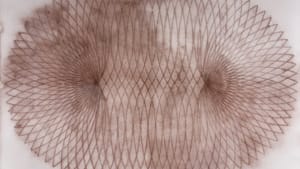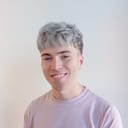Stay in the Loop
BSR publishes on a weekly schedule, with an email newsletter every Wednesday and Thursday morning. There’s no paywall, and subscribing is always free.
An abstraction appetizer
Woodmere Art Museum presents JUST IN: Form + Space, Near + Far

Woodmere Art Museum’s JUST IN: Form + Space, Near + Far, running through July 16, 2023, features seven abstract artists with local ties. While small, the exhibition offers a unique sampling of different approaches to abstraction, and can serve as a great introduction to each artist’s work.
Upon entering the gallery, I was initially struck by the quiet effect all the work had together. This isn’t the colorful abstraction of the Sam Maitin sculptures which playfully beckon visitors from the outdoor garden. Instead, most of these artists work with the natural color of their materials: red clay, gray graphite, or the warm honey color of resin. In work where paint or pigment is used, it is generally subdued and earthy. Even James Havard’s painting, the largest piece in the exhibition, containing an array of pearlescent pastels, seems restrained in context with the rest of his oeuvre of brightly colored abstract illusionist works.
Symmetry and balance
For those who frequent Philadelphia art galleries, many of the artists in the exhibition will be instantly familiar, such as William Daley, who passed at the age of 96 last year. Daley’s large-scale unglazed stoneware vessel, Guardian Vesica (2005), sits at the center of the exhibition. This sturdy structure anchors all the other pieces in the room, as it seems in conversation with every piece that you see beyond it from each vantage point.
Like Daley’s vessel, many compositions feature symmetry and balance, contributing to the peaceful quality of the exhibition. This is the case with Mary Judge’s work on paper, Spiral Form Series #1 (2003), the image used to advertise the exhibition. The drawing itself is even more delicate in person, and I was fascinated to learn how the intricate spirals were made from sifting powder repeatedly through a stencil.
A sampling of seven
Considering Judge’s method, I became increasingly aware of two divergent approaches to abstraction featured in the exhibition. In one approach, process dictates the final forms, also evident in the work of David Slovic. Slovic’s Melenge 1 (2013) consists of hundreds of coils of tape, combining to form an elegant texture. In the other approach, the process is less obvious, and not a central aspect of the final artwork, as in the meticulous graphite drawing Cluster (2013) by Stephen Talasnik. The longer I spent looking, the more I began to question whether these two approaches coalesced into a cohesive exhibition.
Furthermore, with each artist represented by only one work (except for Winifred Lutz, who has two in this show), I found it disappointing not being able to see some pieces in context with the artist’s other work. But then I realized that this isn’t what this exhibition aims to do. It’s a sampling, an appetizer, of seven prominent abstract artists with connections to Philadelphia.
If you are hungry for more, there will be a gallery talk in conjunction with JUST IN: Form + Space, Near + Far on Monday, May 1, at 2pm, led by Hildy Tow, Woodmere’s Robert L. McNeil Jr. curator of education. Although the museum is normally closed on Mondays, this program is free and open to the public.
What, When, Where
JUST IN: Form + Space, Near + Far. Through July 16, 2023, at Woodmere Art Museum, 9201 Germantown Avenue, Philadelphia. (215) 247-0476 or woodmereartmuseum.org.
Accessibility
Wheelchairs are available upon request. All galleries, with the exception of the Dorothy del Bueno balcony, are wheelchair-accessible. Accessible parking is available near the Widener Studio building, located to the right of the museum.
Masks are encouraged, but not required.
Sign up for our newsletter
All of the week's new articles, all in one place. Sign up for the free weekly BSR newsletters, and don't miss a conversation.

 Jake Foster
Jake Foster